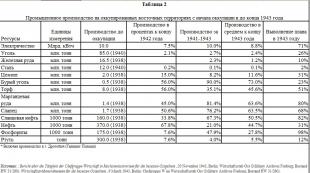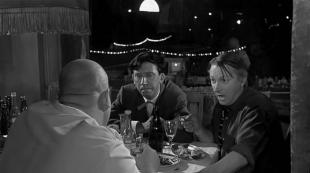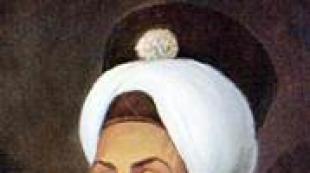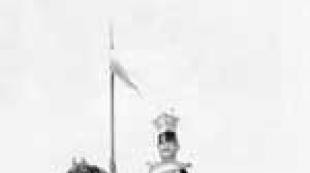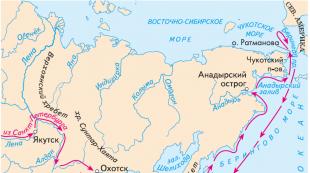Video tutorial "Multiplication of decimal fractions. Operations with decimal fractions Multiply decimal fractions of a number
§ 1 Application of the rule for multiplying decimal fractions
In this lesson, you will introduce and learn how to apply the rule for multiplying decimals and the rule for multiplying a decimal by a place unit such as 0.1, 0.01, etc. In addition, we will consider the properties of multiplication when finding the values of expressions containing decimal fractions.
Let's solve the problem:
The vehicle speed is 59.8 km/h.
How far will the car travel in 1.3 hours?
As you know, to find a path, you need to multiply the speed by the time, i.e. 59.8 times 1.3.

Let's write the numbers in a column and start multiplying them without noticing the commas: 8 times 3 will be 24, 4 we write 2 in our minds, 3 times 9 is 27, plus 2, we get 29, we write 9, 2 in our minds. Now we multiply 3 by 5, it will be 15 and add 2 more, we get 17.
Go to the second line: 1 times 8 is 8, 1 times 9 is 9, 1 times 5 is 5, add these two lines, we get 4, 9+8 is 17, 7 write 1 in your head, 7 +9 is 16 plus 1, it will be 17, 7 we write 1 in our mind, 1+5 plus 1 we get 7.
Now let's see how many decimal places are in both decimal fractions! The first fraction has one digit after the decimal point and the second fraction has one digit after the decimal point, two digits in total. So, on the right in the result you need to count two digits and put a comma, i.e. will be 77.74. So, when multiplying 59.8 by 1.3, we got 77.74. So the answer in the problem is 77.74 km.
Thus, to multiply two decimal fractions, you need:
First: do the multiplication, ignoring the commas
Second: in the resulting product, separate with a comma as many digits on the right as there are after the comma in both factors together.
If there are fewer digits in the resulting product than it is necessary to separate with a comma, then one or more zeros must be assigned in front.
For example: 0.145 times 0.03 we get 435 in the product, and we need to separate 5 digits on the right with a comma, so we add 2 more zeros before the number 4, put a comma and add another zero. We get the answer 0.00435.
§ 2 Properties of multiplication of decimal fractions
When multiplying decimal fractions, all the same multiplication properties that apply to natural numbers are preserved. Let's do some tasks.
Task number 1:
![]()
Let's solve this example by applying the distributive property of multiplication with respect to addition.
5.7 (common factor) will be taken out of the brackets, 3.4 plus 0.6 will remain in brackets. The value of this sum is 4, and now 4 must be multiplied by 5.7, we get 22.8.
Task number 2:
![]()
Let's use the commutative property of multiplication.
We first multiply 2.5 by 4, we get 10 integers, and now we need to multiply 10 by 32.9 and we get 329.
In addition, when multiplying decimal fractions, you can notice the following:
When multiplying a number by an improper decimal fraction, i.e. greater than or equal to 1, it increases or does not change, for example:
![]()
When multiplying a number by a proper decimal fraction, i.e. less than 1, it decreases, for example:
![]()
Let's solve an example:
23.45 times 0.1.
We have to multiply 2,345 by 1 and separate three commas from the right, we get 2.345.
![]()
Now let's solve another example: 23.45 divided by 10, we have to move the comma to the left by one place, because 1 zero in a bit one, we get 2.345.
From these two examples, we can conclude that multiplying a decimal by 0.1, 0.01, 0.001, etc. means dividing the number by 10, 100, 1000, etc., i.e. in a decimal fraction, move the decimal point to the left by as many digits as there are zeros in front of 1 in the multiplier.
Using the resulting rule, we find the values of the products:
13.45 times 0.01
there are 2 zeros in front of the number 1, so we move the comma to the left by 2 digits, we get 0.1345.
0.02 times 0.001
there are 3 zeros in front of the number 1, which means we move the comma three digits to the left, we get 0.00002.
Thus, in this lesson you have learned how to multiply decimal fractions. To do this, you just need to perform the multiplication, ignoring the commas, and in the resulting product, separate as many digits on the right with a comma as there are after the comma in both factors together. In addition, they got acquainted with the rule for multiplying a decimal fraction by 0.1, 0.01, etc., and also considered the properties of multiplying decimal fractions.
List of used literature:
- Mathematics 5th grade. Vilenkin N.Ya., Zhokhov V.I. and others. 31st ed., ster. - M: 2013.
- Didactic materials in mathematics Grade 5. Author - Popov M.A. - year 2013
- We calculate without errors. Work with self-examination in mathematics grades 5-6. Author - Minaeva S.S. - year 2014
- Didactic materials in mathematics Grade 5. Authors: Dorofeev G.V., Kuznetsova L.V. - 2010
- Control and independent work in mathematics Grade 5. Authors - Popov M.A. - year 2012
- Maths. Grade 5: textbook. for general education students. institutions / I. I. Zubareva, A. G. Mordkovich. - 9th ed., Sr. - M.: Mnemosyne, 2009
In this article, we will consider such an action as multiplying decimal fractions. Let's start with the formulation of general principles, then we will show how to multiply one decimal fraction by another and consider the method of multiplication by a column. All definitions will be illustrated with examples. Then we will analyze how to correctly multiply decimal fractions by ordinary, as well as by mixed and natural numbers (including 100, 10, etc.)
As part of this material, we will only touch on the rules for multiplying positive fractions. Cases with negative numbers are discussed separately in the articles on the multiplication of rational and real numbers.
Let us formulate the general principles that must be followed when solving problems on the multiplication of decimal fractions.
To begin with, let us recall that decimal fractions are nothing more than a special form of writing ordinary fractions, therefore, the process of their multiplication can be reduced to the same for ordinary fractions. This rule works for both finite and infinite fractions: after converting them to ordinary fractions, it is easy to perform multiplication with them according to the rules we have already studied.
Let's see how such tasks are solved.
Example 1
Compute the product of 1.5 and 0.75.
Solution: First, replace the decimal fractions with ordinary ones. We know that 0.75 is 75/100 and 1.5 is 1510. We can reduce the fraction and extract the whole part. We will write the result 125 1000 as 1 , 125 .
Answer: 1 , 125 .
We can use the column counting method as we do for natural numbers.
Example 2
Multiply one periodic fraction 0 , (3) by another 2 , (36) .
First, let's reduce the original fractions to ordinary ones. We will be able to:
0 , (3) = 0 , 3 + 0 , 03 + 0 , 003 + 0 , 003 + . . . = 0 , 3 1 - 0 , 1 = 0 , 3 9 = 3 9 = 1 3 2 , (36) = 2 + 0 , 36 + 0 , 0036 + . . . = 2 + 0 , 36 1 - 0 , 01 = 2 + 36 99 = 2 + 4 11 = 2 4 11 = 26 11
Therefore, 0 , (3) 2 , (36) = 1 3 26 11 = 26 33 .
The resulting ordinary fraction can be reduced to decimal form by dividing the numerator by the denominator in a column:
Answer: 0 , (3) 2 , (36) = 0 , (78) .
If we have infinite non-periodic fractions in the condition of the problem, then we need to perform their preliminary rounding (see the article on rounding numbers if you forgot how to do this). After that, you can perform the multiplication operation with already rounded decimal fractions. Let's take an example.
Example 3
Compute the product of 5 , 382 ... and 0 , 2 .
Solution
We have an infinite fraction in the problem, which must first be rounded to hundredths. It turns out that 5, 382 ... ≈ 5, 38. Rounding the second factor to hundredths does not make sense. Now you can calculate the desired product and write down the answer: 5, 38 0, 2 = 538 100 2 10 = 1 076 1000 = 1, 076.
Answer: 5.382… 0.2 ≈ 1.076.
The column counting method can be applied not only to natural numbers. If we have decimals, we can multiply them in exactly the same way. Let's derive the rule:
Definition 1
Multiplication of decimal fractions by a column is performed in 2 steps:
1. We perform multiplication by a column, not paying attention to commas.
2. We put a decimal point in the final number, separating it as many digits on the right side as both factors contain decimal places together. If as a result there are not enough numbers for this, we add zeros on the left.
We will analyze examples of such calculations in practice.
Example 4
Multiply the decimals 63, 37 and 0, 12 by a column.
Solution
First of all, let's do the multiplication of numbers, ignoring the decimal points.

Now we need to put a comma in the right place. It will separate the four digits on the right side since the sum of the decimal places in both factors is 4 . You don't have to add zeros, because signs are enough.

Answer: 3.37 0.12 = 7.6044.
Example 5
Calculate how much is 3.2601 times 0.0254.
Solution
We count without commas. We get the following number:

We will put a comma separating 8 digits on the right side, because the original fractions together have 8 decimal places. But our result has only seven digits, and we can't do without extra zeros:

Answer: 3.2601 0.0254 = 0.08280654.
How to multiply a decimal by 0.001, 0.01, 01, etc
You often have to multiply decimals by such numbers, so it is important to be able to do this quickly and accurately. We write down a special rule that we will use in such multiplication:
Definition 2
If we multiply the decimal by 0, 1, 0, 01, etc., we end up with a number that looks like the original fraction, with the decimal point moved to the left by the required number of places. If there are not enough digits to transfer, you need to add zeros on the left.
So, to multiply 45, 34 by 0, 1, the comma must be moved in the original decimal fraction by one sign. We end up with 4,534.
Example 6
Multiply 9.4 by 0.0001.
Solution
We will have to move the comma to four digits according to the number of zeros in the second factor, but the numbers in the first are not enough for this. We assign the necessary zeros and get that 9, 4 0, 0001 = 0, 00094.
Answer: 0 , 00094 .
For infinite decimals, we use the same rule. So, for example, 0 , (18) 0 , 01 = 0 , 00 (18) or 94 , 938 … 0 , 1 = 9 , 4938 … . and etc.
The process of such a multiplication is no different from the action of multiplying two decimal fractions. It is convenient to use the multiplication method in a column if the condition of the problem contains a final decimal fraction. In this case, it is necessary to take into account all the rules that we talked about in the previous paragraph.
Example 7
Calculate how much will be 15 2, 27.
Solution
Multiply the original numbers by a column and separate the two commas.

Answer: 15 2.27 = 34.05.
If we perform the multiplication of a periodic decimal fraction by a natural number, we must first change the decimal fraction to an ordinary one.
Example 8
Compute the product of 0 , (42) and 22 .
We bring the periodic fraction to the form of an ordinary fraction.
0 , (42) = 0 , 42 + 0 , 0042 + 0 , 000042 + . . . = 0 , 42 1 - 0 , 01 = 0 , 42 0 , 99 = 42 99 = 14 33
0, 42 22 = 14 33 22 = 14 22 3 = 28 3 = 9 1 3
The final result can be written as a periodic decimal fraction as 9 , (3) .
Answer: 0 , (42) 22 = 9 , (3) .
Infinite fractions must be rounded before counting.
Example 9
Calculate how much will be 4 2 , 145 ... .
Solution
Let's round up to hundredths the original infinite decimal fraction. After that, we will come to the multiplication of a natural number and a final decimal fraction:
4 2, 145 ... ≈ 4 2, 15 = 8, 60.
Answer: 4 2.145 ... ≈ 8.60.
How to multiply a decimal by 1000, 100, 10, etc.
Multiplying a decimal fraction by 10, 100, etc. is often found in problems, so we will analyze this case separately. The basic multiplication rule is:
Definition 3
To multiply a decimal by 1000, 100, 10, etc., you need to move its comma by 3, 2, 1 digits depending on the multiplier and discard extra zeros on the left. If there are not enough digits to move the comma, we add as many zeros to the right as we need.
Let's show an example how to do it.
Example 10
Do the multiplication of 100 and 0.0783.
Solution
To do this, we need to move the decimal point by 2 digits to the right. We end up with 007 , 83 The zeros on the left can be discarded and the result can be written as 7 , 38 .
Answer: 0.0783 100 = 7.83.
Example 11
Multiply 0.02 by 10 thousand.
Solution: we will move the comma four digits to the right. In the original decimal fraction, we do not have enough signs for this, so we have to add zeros. In this case, three 0's will suffice. As a result, it turned out 0, 02000, move the comma and get 00200, 0. Ignoring the zeros on the left, we can write the answer as 200 .
Answer: 0.02 10,000 = 200.
The rule we have given will work in the same way in the case of infinite decimal fractions, but here you should be very careful about the period of the final fraction, since it is easy to make a mistake in it.
Example 12
Compute the product of 5.32 (672) times 1000 .
Solution: first of all, we will write the periodic fraction as 5, 32672672672 ..., so the probability of making a mistake will be less. After that, we can move the comma to the desired number of characters (three). As a result, we get 5326 , 726726 ... Let's put the period in brackets and write the answer as 5 326 , (726) .
Answer: 5 . 32 (672) 1 000 = 5 326 . (726) .
If in the conditions of the problem there are infinite non-periodic fractions that must be multiplied by ten, one hundred, one thousand, etc., do not forget to round them before multiplying.
To perform this type of multiplication, you need to represent the decimal fraction as an ordinary fraction and then follow the already familiar rules.
Example 13
Multiply 0 , 4 by 3 5 6
Solution
Let's first convert the decimal to a common fraction. We have: 0 , 4 = 4 10 = 2 5 .
We got the answer as a mixed number. You can write it as a periodic fraction 1, 5 (3) .
Answer: 1 , 5 (3) .
If an infinite non-periodic fraction is involved in the calculation, you need to round it up to a certain number and only then multiply it.
Example 14
Calculate the product of 3.5678. . . 2 3
Solution
We can represent the second factor as 2 3 = 0, 6666 …. Next, we round both factors to the thousandth place. After that, we will need to calculate the product of two final decimal fractions 3.568 and 0.667. Let's count the column and get the answer:

The final result must be rounded to thousandths, since it was to this category that we rounded the original numbers. We get that 2.379856 ≈ 2.380.
Answer: 3, 5678. . . 2 3 ≈ 2.380
If you notice a mistake in the text, please highlight it and press Ctrl+Enter
You already know that a * 10 = a + a + a + a + a + a + a + a + a + a. For example, 0.2 * 10 = 0.2 + 0.2 + 0.2 + 0.2 + 0.2 + 0.2 + 0.2 + 0.2 + 0.2 + 0.2 . It is easy to guess that this sum is equal to 2, i.e. 0.2 * 10 = 2.
Similarly, one can verify that:
5,2 * 10 = 52 ;
0,27 * 10 = 2,7 ;
1,253 * 10 = 12,53 ;
64,95 * 10 = 649,5 .
You probably guessed that when multiplying a decimal fraction by 10, you need to move the decimal point to the right by one digit in this fraction.
How do you multiply a decimal by 100?
We have: a * 100 = a * 10 * 10 . Then:
2,375 * 100 = 2,375 * 10 * 10 = 23,75 * 10 = 237,5 .
Arguing similarly, we get that:
3,2 * 100 = 320 ;
28,431 * 100 = 2843,1 ;
0,57964 * 100 = 57,964 .
Multiply the fraction 7.1212 by the number 1000.
We have: 7.1212 * 1000 = 7.1212 * 100 * 10 = 712.12 * 10 = 7121.2.
These examples illustrate the following rule.
To multiply a decimal fraction by 10, 100, 1,000, etc., you need to move the decimal point to the right in this fraction, respectively, by 1, 2, 3, etc. numbers.
So, if you move the comma to the right by 1, 2, 3, etc. numbers, then the fraction will increase by 10, 100, 1,000, etc., respectively. once.
Consequently, if you move the comma to the left by 1, 2, 3, etc. numbers, then the fraction will decrease by 10, 100, 1,000, etc., respectively. once .
Let's show that the decimal notation of fractions makes it possible to multiply them, guided by the rule of multiplication of natural numbers.
Let's find, for example, the product 3.4 * 1.23. Let's increase the first multiplier by 10 times, and the second by 100 times. This means that we have increased the product by 1,000 times.
Therefore, the product of natural numbers 34 and 123 is 1,000 times greater than the desired product.
We have: 34 * 123 = 4182. Then, to get an answer, the number 4,182 must be reduced by 1,000 times. Let's write: 4 182 \u003d 4 182.0. Moving the comma in 4182.0 three digits to the left, we get the number 4.182, which is 1000 times less than the number 4182. So 3.4 * 1.23 = 4.182 .
The same result can be obtained using the following rule.
To multiply two decimals:
1) multiply them as natural numbers, ignoring commas;
2) in the resulting product, separate with a comma on the right as many digits as there are after the commas in both factors together.
In cases where the product contains fewer digits than is required to be separated by a comma, the required number of zeros is added to the left before this product, and then the comma is moved to the left by the required number of digits.
For example, 2 * 3 = 6, then 0.2 * 3 = 0.006; 25 * 33 = 825, then 0.025 * 0.33 = 0.00825.
In cases where one of the factors is equal to 0.1; 0.01; 0.001, etc., it is convenient to use the following rule.
To multiply a decimal by 0.1 ; 0.01; 0.001, etc., it is necessary to move the comma to the left in this fraction, respectively, by 1, 2, 3, etc. numbers.
For example, 1.58 * 0.1 = 0.158; 324.7 * 0.01 = 3.247.
The properties of multiplication of natural numbers are also valid for fractional numbers:
ab = ba − commutative property of multiplication,
(ab) c = a(b c) − the associative property of multiplication,
a(b + c) = ab + ac is the distributive property of multiplication with respect to addition.
Like regular numbers.
2. We count the number of decimal places for the 1st decimal fraction and for the 2nd. We add up their number.
3. In the final result, we count from right to left such a number of digits as they turned out in the paragraph above, and put a comma.
Rules for multiplying decimals.
1. Multiply without paying attention to the comma.
2. In the product, we separate as many digits after the decimal point as there are after the commas in both factors together.
Multiplying a decimal fraction by a natural number, you must:
1. Multiply numbers, ignoring the comma;
2. As a result, we put a comma so that there are as many digits to the right of it as in a decimal fraction.
Multiplication of decimal fractions by a column.
Let's look at an example:
We write decimal fractions in a column and multiply them as natural numbers, ignoring the commas. Those. We consider 3.11 as 311, and 0.01 as 1.
The result is 311. Next, we count the number of decimal places (digits) for both fractions. There are 2 digits in the 1st decimal and 2 in the 2nd. The total number of digits after the decimal points:
2 + 2 = 4
We count from right to left four characters of the result. There are fewer numbers in the final result than you need to separate with a comma. In this case, it is necessary to add the missing number of zeros on the left.
In our case, the 1st digit is missing, so we add 1 zero on the left.

Note:
Multiplying any decimal fraction by 10, 100, 1000, and so on, the comma in the decimal fraction is moved to the right by as many places as there are zeros after the one.
For example:
70,1 . 10 = 701
0,023 . 100 = 2,3
5,6 . 1 000 = 5 600
Note:
To multiply a decimal by 0.1; 0.01; 0.001; and so on, you need to move the comma to the left in this fraction by as many characters as there are zeros in front of the unit.
We count zero integers!
For example:
12 . 0,1 = 1,2
0,05 . 0,1 = 0,005
1,256 . 0,01 = 0,012 56
Back forward
Attention! The slide preview is for informational purposes only and may not represent the full extent of the presentation. If you are interested in this work, please download the full version.
The purpose of the lesson:
- In a fun way, introduce students to the rule of multiplying a decimal fraction by a natural number, by a bit unit and the rule of expressing a decimal fraction as a percentage. Develop the ability to apply the acquired knowledge in solving examples and problems.
- To develop and activate the logical thinking of students, the ability to identify patterns and generalize them, strengthen memory, the ability to cooperate, provide assistance, evaluate their work and the work of each other.
- To cultivate interest in mathematics, activity, mobility, ability to communicate.
Equipment: interactive board, a poster with a cyphergram, posters with mathematicians' statements.
During the classes
- Organizing time.
- Oral counting is a generalization of previously studied material, preparation for the study of new material.
- Explanation of new material.
- Homework assignment.
- Mathematical physical education.
- Generalization and systematization of the acquired knowledge in a playful way with the help of a computer.
- Grading.
2. Guys, today our lesson will be somewhat unusual, because I will not spend it alone, but with my friend. And my friend is also unusual, now you will see him. (A cartoon computer appears on the screen.) My friend has a name and he can talk. What's your name, friend? Komposha replies: "My name is Komposha." Are you ready to help me today? YES! Well then, let's start the lesson.

Today I received an encrypted cyphergram, guys, which we must solve and decipher together. (A poster is posted on the board with an oral account for adding and subtracting decimal fractions, as a result of which the guys get the following code 523914687. )
| 5 | 2 | 3 | 9 | 1 | 4 | 6 | 8 | 7 |
| 1 | 2 | 3 | 4 | 5 | 6 | 7 | 8 | 9 |
Komposha helps to decipher the received code. As a result of decoding, the word MULTIPLICATION is obtained. Multiplication is the keyword of the topic of today's lesson. The topic of the lesson is displayed on the monitor: “Multiplying a decimal fraction by a natural number”
Guys, we know how the multiplication of natural numbers is performed. Today we will consider the multiplication of decimal numbers by a natural number. The multiplication of a decimal fraction by a natural number can be considered as the sum of terms, each of which is equal to this decimal fraction, and the number of terms is equal to this natural number. For example: 5.21 3 \u003d 5.21 + 5, 21 + 5.21 \u003d 15.63 So 5.21 3 = 15.63. Representing 5.21 as an ordinary fraction of a natural number, we get
And in this case, we got the same result of 15.63. Now, ignoring the comma, let's take the number 521 instead of the number 5.21 and multiply by the given natural number. Here we must remember that in one of the factors the comma is moved two places to the right. When multiplying the numbers 5, 21 and 3, we get a product equal to 15.63. Now, in this example, we will move the comma to the left by two digits. Thus, by how many times one of the factors was increased, the product was reduced by so many times. Based on the similar points of these methods, we draw a conclusion.

To multiply a decimal by a natural number, you need:
1) ignoring the comma, perform the multiplication of natural numbers;
2) in the resulting product, separate with a comma on the right as many characters as there are in a decimal fraction.
The following examples are displayed on the monitor, which we analyze together with Komposha and the guys: 5.21 3 = 15.63 and 7.624 15 = 114.34. After I show multiplication by a round number 12.6 50 \u003d 630. Next, I turn to the multiplication of a decimal fraction by a bit unit. Showing the following examples: 7,423 100 \u003d 742.3 and 5.2 1000 \u003d 5200. So, I introduce the rule for multiplying a decimal fraction by a bit unit:

To multiply a decimal fraction by bit units 10, 100, 1000, etc., it is necessary to move the comma to the right in this fraction by as many digits as there are zeros in the bit unit record.
I end the explanation with the expression of a decimal fraction as a percentage. I enter the rule:

To express a decimal as a percentage, multiply it by 100 and add the % sign.
I give an example on a computer 0.5 100 \u003d 50 or 0.5 \u003d 50%.
4. At the end of the explanation, I give the guys homework, which is also displayed on the computer monitor: № 1030, № 1034, № 1032.

5. In order for the guys to rest a little, to consolidate the topic, we do a mathematical physical education session together with Komposha. Everyone stands up, shows the class the solved examples and they must answer whether the example is correct or incorrect. If the example is solved correctly, then they raise their hands above their heads and clap their palms. If the example is not solved correctly, the guys stretch their arms to the sides and knead their fingers.

6. And now you have a little rest, you can solve the tasks. Open your textbook to page 205, № 1029. in this task it is necessary to calculate the value of expressions:
Tasks appear on the computer. As they are solved, a picture appears with the image of a boat, which, when fully assembled, sails away.
No. 1031 Calculate:

Solving this task on a computer, the rocket gradually develops, solving the last example, the rocket flies away. The teacher gives a little information to the students: “Every year, spaceships take off to the stars from the Kazakhstani land from the Baikonur Cosmodrome. Near Baikonur, Kazakhstan is building its new Baiterek cosmodrome.
No. 1035. Task.
How far will a car travel in 4 hours if the speed of the car is 74.8 km/h.

This task is accompanied by sound design and displaying a brief condition of the task on the monitor. If the problem is solved, right, then the car starts to move forward to the finish flag.
№ 1033. Write decimals as percentages.
0,2 = 20%; 0,5 = 50%; 0,75 = 75%; 0,92 = 92%; 1,24 =1 24%; 3,5 = 350%; 5,61= 561%.
Solving each example, when the answer appears, a letter appears, resulting in the word Well done.

The teacher asks Komposha, why would this word appear? Komposha replies: “Well done, guys!” and say goodbye to everyone.
The teacher sums up the lesson and assigns grades.
